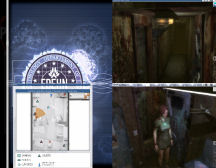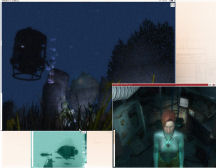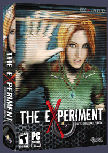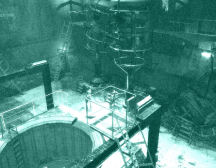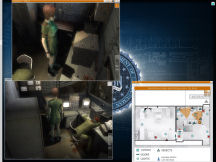The Experiment
is an innovative, immersive, frustrating gaming experience. It ranks high
in terms of plot complexity and puzzle difficulty. It introduces an
engaging heroine, while keeping her mostly at a distance, glimpsed through
the lens of a security camera. Reaching The Experiment’s end
requires persistence, intense concentration and the ability to focus on
the right thing, using the right camera at the right time.
What on Earth Happened Here?
The game opens with surreal images showing a tropical island where a
research ship lies anchored. We zoom through the Project EDEHN ship to the
body of a woman, who is wearing either prison or hospital garb, lying
prone with an intravenous line in her arm. She awakens, and the gamer’s
odd partnership with this woman, Professor Lea Nichols, begins. Lea is a
scientist who was involved in top secret experiments involving animals and
humans. While she was sleeping, something horrible occurred on this ship,
leaving rooms empty and in disarray. Lea has only partial memories of what
happened before the final experiment. She needs your help in opening
doors, accessing computers, and negotiating obstacles to find a
life-sustaining chemical substance. After that, she needs assistance in
finding a way off the ship.
The Scenic Route
The graphics in The Experiment are unique. The images are often
cramped and grainy. That’s because everything you see (with the exception
of a few flashbacks) is viewed through security cameras scattered
throughout the ship and its environs. This works surprisingly well, adding
to the gritty ambiance aboard ship. The austere quality of the early
interiors provides an effective contrast to later sequences, where Lea
stumbles across the jaw-dropping places hidden from all but a handful of
EDEHN’s top researchers.
If this is EDEHN, Where is Adam?
The story of Project EDEHN is told through flashbacks, computer files,
and documentary videos. As you read through the documents and emails in
the ship’s computer, you learn more about the attractive, vulnerable,
determined Lea. You also unearth the background of the other scientists,
and you find clues that reveal the subject and full scope of their
mysterious research.
At first, I wasn’t particularly curious about Lea’s colleagues, and
read through the files mostly to find clues to passwords and other
practical information. (A helpful feature: many of the passwords are
available in more than one location, giving you a better chance at finding
them or figuring them out.) Before long, I found myself reading these
files more for the gossip than for the clues. I became so absorbed by the
loves, tragedies and quirks of the people on the ship that I left poor Lea
standing in place for hours. I was immensely entertained as I snooped
through the files, decoded passwords, and discovered how the characters’
private behaviors belied their public personae. (Warning: stay on good
terms with the IT expert at your workplace -- he probably knows more about
you than you do.)
In fact, the Project EDEHN participants were so accomplished at duping,
blackmailing, and spying on one another that I started to wonder how
certain individuals had managed to get through a high level security
screening. The game provides an explanation toward the end that fits
nicely within the developing story.
The game’s ending comes abruptly and, given the story up to that point,
doesn’t make a lot of sense. The culminating confrontation between the
major characters is never shown, but only sketchily described as a sort of
afterthought. This is profoundly unsatisfying – unless, of course, the
developers plan a sequel, which perhaps could start by showing us this
confrontation.
Sounds Like…
Voiceovers for this game are professionally done. Kudos to Sarah Ripard,
who (I gather) voiced the role of Lea Nichols (the credits don’t give
individual attribution, but Ms. Ripard’s name appears first). The only
times I tired of Lea’s voice were the occasions when she used the same
phrase over and over. This wore thin quickly. I was surprised by the
number of actors’ names listed in the final credits. I had “bought into”
the characters so thoroughly, and the voice work in the documentary videos
was so authentic, that I didn’t even think about the involvement of
actors.
The background sounds and music are exotic and futuristic. They
emphasize layers of sound rather than melody, and feature unusual beats,
watery sounds, birdlike trills, twangs, clangs, and metallic echoes. At
different times the music is eerie, disturbing, soothing, and
contemplative.
Be Sure to Cover Every Angle
Before you get to the heart of the mystery, you’ll have to master
The Experiment’s unusual interface. You switch on security cameras
that monitor Lea as she moves through the ship. You can also hear her when
she speaks. The only way that you can communicate with her, though, is by
activating something near her so that she walks in that direction – for
instance, by turning a light on or off. The process of guiding Lea this
way is slow and sometimes frustrating, as she doesn’t always react to a
light or object that clearly is within her view.
It’s essential to keep several windows open on the screen
simultaneously. These often overlap one another, covering up the bottom
window completely. You can set the camera windows to three different
sizes. Though usually the medium-size window is fine, there were instances
where I had to use the largest window and then zoom in on something to see
it clearly.
While learning to use the cameras, you also must learn how to use the
map, through which you access the game’s hotspots. Each portion of the map
shows dozens of tiny circles (representing lights), triangles
(representing interactive objects), lines (doors) and squarish symbols
(cameras), as well as tiny arrows for changing the vertical orientation of
the map. Sometimes the symbols are so close together that delicate mouse
movements are required to find the pixel that separates one from the
other. Also, on my computer, the cursor tended to “float,” which meant
that I had to aim the cursor carefully to get it to settle on many of the
hotspots.
Inconsistency
It is essential to study the game’s manual. I usually trudge through
manuals out of a sense of duty more than anything else. In this case, I
got a highlighter pen and highlighted the important bits so I could reread
them until I had grasped all the details of the interface. Unfortunately,
the manual sometimes uses different terminology than the game interface or
the character dialog. For instance, Lea instructs you to type in someone’s
“Alias,” when the manual and the game interface call that the “UserName.”
The “Area Map” is also known as the “Plan,” the laundry is called the “bleachery,”
“accreditation” means the same thing as “validate” and so on. These
multiple terms -- on top of an already complex interface -- created
unnecessary confusion.
This game requires a huge amount of reading, a significant amount of
note taking, and a goodly amount of guessing. The note taking is important
because you need to remember where you obtained certain information,
including the processes for breaking codes and the procedures for
operating machines.
The guessing comes into play because a few of the clues are wrong. For
instance, the puzzle solution for one password has six letters, while the
code that actually works has eight. One hyphenated user name appears in
two variants, neither of which functions to access that person’s files.
One password is revealed via video for only a second, and the last letter
is so blurry it looks like two letters. When operating various machinery,
Lea often gives the wrong instructions for its use (for example,
suggesting that you use the keyboard when the machine interface only
responds to the mouse). There is a Hint system, but it is not particularly
helpful. Only once was it a useful guide when I was stuck.
I hit two dead ends in the game. Both occurred while using robotic
arms. In one instance, I saved the game midway through the challenge. Upon
my return, I could no longer use the device and had to replay from an
earlier save. In the other instance, I was fooled by an optical illusion
into thinking that a button was just a white corner space. Random, fierce
clicking permanently minimized the interface into an unresponsive toolbar.
Another glitch caused the audio transcript (which can be important in
solving the puzzles) to be deleted every time I exited the game.
A Save! A Save! My Kingdom for a Save!
The Experiment provides seven save slots, plus an autosave. The
autosave does not return the gamer to the exact point where the gamer left
off, but picks up again at a standard set point sometime before that – a
disorienting annoyance. And eight save slots is ridiculously inadequate
for a game of this length and difficulty.
About thirty hours into the game, I hit a sequence of challenges where
the game would no longer let me save my progress at all. I started this
sequence a little after nine o’clock one sunny morning, with an amusing
challenge involving airborne flower pods. Getting through the pods took me
some time, as the goal Lea had stated (combined with common sense), turned
out to be completely wrong. At this point, I was used to a certain amount
of randomness in The Experiment’s challenges, so I finally chose to
go with what worked instead of what made sense.
Suddenly and unexpectedly, I was swept away by the plot events to yet
another challenge, and again wasn’t allowed to save. Here Lea is forced to
appear before the High Council to communicate her status and intentions.
This challenge is the most difficult in the game. It’s a timed puzzle,
made nearly impossible by the imprecise motion of the camera combined with
a brutally unforgiving clock. I struggled with it until I had to leave for
a lunch appointment. I didn’t want to lose all progress from the flower
pods, and I had learned from sorry experience not to trust the game’s
autosave. So I left the game running the whole time I was at lunch,
returning to find Lea impatient and complaining, but still standing there.
After figuring out that I would never satisfy the High Council until I
had tweaked portions of the game’s interface, I finally made the
adjustments that (with lots of practice) brought the High Council’s
grilling to an end. Immediately the game put me in front of a device that
had to be disabled -- another timed puzzle -- and again a sequence where I
couldn’t save. It was late afternoon and for the second time I had to
leave the computer.
I left the game running, and returned at five o’clock, when I received
good news and bad news. The bad news was that the game had recorded my
inaction as a failure and had proceeded on its merry way without me. The
good news was that I had at last reached a point the game deemed suitable
for “backing up” my progress. It took the equivalent of a full workday,
subtracting lunch and a quick break, before I could save my game.
It Comes Down to This
There were times when I loved The Experiment – discovering the
amazing creature in Tank 8, exploring the watery world in the bathysphere,
the “light bulb” moments when I cracked some of the codes. There were also
hours when I was frustrated in the extreme.
I realize that reaching perfection in translating the game instructions
and clues into English must have been enormously challenging due to The
Experiment’s length and complexity. Nevertheless, there should be a
basic trust on the part of the gamer that clues are precise when given,
that the player character isn’t flummoxing the gamer with useless
instructions, that terms are consistent, and that a sluggishly-responding
camera won’t make timed puzzles virtually impossible. I stopped trusting
the game’s basic puzzle integrity about midway through, and later
challenges didn’t change my opinion.
Furthermore, the scarcity of save game slots combined with the
inability to save during the most difficult challenges gives the
impression that this is a game for leisured, hardcore gamers. The type of
gamers who don’t face the demands of a real life.
Quick List for The Experiment
A great idea for an adventure game, with a brilliant story and unique
visuals and gaming style. A lovely, spunky heroine.
Combines first person and third person perspectives, point-and-click,
limited panning within individual windows. Hundreds of tiny symbols on a
map that must be clicked on. Multiple windows open at all times, which can
be confusing. A deserted research ship with secrets concealed within
secrets. Story told through flashbacks, computer files and videos. Lots of
reading. Unusually lengthy, complex gameplay.
Good voiceovers, beautiful ambient music that sets the mood well. Brief
female nudity obscured by shadows. Some adult themes, though sensitively
handled.
You can’t die. Two dead ends that required replaying from a previous
save.
Challenges involve cracking codes, searching through computer files for
information, using robotic arms, driving a bathysphere, communicating in a
new language. Challenges are integrated into the story unusually well. No
sliders, no mazes, no auditory puzzles or color based puzzles, though
using the map icons sometimes requires distinguishing colors.
The most difficult puzzles – a wicked timed challenge where you click
on symbols and aim a camera that’s difficult to point in the right
direction. Also, a temperature gauge puzzle where the correct reading
sometimes can’t be reached without leaving the room and returning. Some
inaccurate clues and instructions result in the gamer being forced to
guess well or to consult a walkthrough. Several challenges do not allow
you to save until you have beaten the challenge.
The manual is a must-read. The interface involves a steep learning
curve. Seven save slots plus an autosave (not nearly enough). Installation
was smooth. No crashes. A couple of minor graphical glitches that didn’t
impact gameplay, a glitch causing the audio transcript to delete itself
upon exiting the game.
The Experiment is aimed at patient gamers who value innovation,
enjoy putting a new interface through its paces, and appreciate a deeply
layered plot.
Final Grade: C+
My Computer Specs:
Windows XP Professional
Pentium 2.80 GHz
2046 MB RAM
Direct X 9.0c
512 MB NVIDIA GeForce 7800 GTX
SB X-Fi Audio
March 2008
design copyright ©
2008
GameBoomers
Group
